A History of the County of Buckingham: Volume 4. Originally published by Victoria County History, London, 1927.
This free content was digitised by double rekeying. All rights reserved.
'Parishes : Kingsey', in A History of the County of Buckingham: Volume 4, ed. William Page (London, 1927), British History Online https://prod.british-history.ac.uk/vch/bucks/vol4/pp63-68 [accessed 23 April 2025].
'Parishes : Kingsey', in A History of the County of Buckingham: Volume 4. Edited by William Page (London, 1927), British History Online, accessed April 23, 2025, https://prod.british-history.ac.uk/vch/bucks/vol4/pp63-68.
"Parishes : Kingsey". A History of the County of Buckingham: Volume 4. Ed. William Page (London, 1927), British History Online. Web. 23 April 2025. https://prod.british-history.ac.uk/vch/bucks/vol4/pp63-68.
In this section
KINGSEY
Eie, Kingesie (xii cent.); Kingsley (xv cent.); Kingeshay (xvii cent.).
Kingsey is a parish with an area (including the liberty of Tythrop) of 1,431 acres, of which 7 acres are covered by water. (fn. 1) The greater part (1,022 acres) is in permanent grass, while only 315 acres are arable land and 45 acres woods and plantations. (fn. 2) The soil is heavy loam, the subsoil clay, and the chief crops are wheat and beans. The land is level, the height generally being about 240 ft. above the ordnance datum. The parish was transferred to Oxfordshire for civil purposes in 1894. (fn. 3)
The village stands in a central position on the London road, the church being in the middle, with the manor-house and school on the south-east and the vicarage a quarter of a mile to the north-west. A stream feeding a decoy pond forms a part of the northern boundary of the parish.
The following place-names have been found: Parisham, (fn. 4) Rudanache (fn. 5) (xv cent.), Fornyfield and My lord of Essex's ground (20 acres including a vineyard of 5 a. 20 p.) (xvi cent.). (fn. 6)
Tythrop (Duchitorp, xi cent.; Tuphrop, Twythrop, xiii cent.; Titethrop, xiv cent.) is a liberty in the west of Kingsey parish which was assessed in 1086 under Lewknor Hundred, Oxfordshire. (fn. 7) References to it under this hundred have been found to the middle 16th century. (fn. 8) Tythrop House stands in a park of 120 acres. It is a fine stone house and is the seat of Mr. Philip Digby Wykeham, owner of the whole of Tythrop and the greater part of Kingsey.
Saxon antiquities have been found in the parish. (fn. 9)
Manors
Kingsey is not mentioned in the Domesday Survey, but was included under the royal manor of Brill (fn. 10) (q.v.). Henry I granted the land of Kingsey, afterwards KINGSEY MANOR, to William de Bolebec, (fn. 11) and it was held of the barony of Bolebec (fn. 12) by the service of a knight's fee, (fn. 13) last mentioned in 1349. (fn. 14)
Herbert de Bolebec died seised of Kingsey in the time of Henry I, (fn. 15) and his son Gilbert was holding under Henry II. (fn. 16) He died about 1180, (fn. 17) and his son, who in 1185 was in the custody of William de Jarpenville (Charpunville), (fn. 18) is probably the Herbert de Bolebec who was lord of Kingsey about 1197 (fn. 19) and was living in 1210. (fn. 20) William de Bolebec is named later in the century (fn. 21) and Gilbert de Bolebec in 1236. (fn. 22) Gilbert died seised about 1247, when his heir was his son Herbert. (fn. 23) He died about 1268, and was succeeded by his brother Gilbert de Bolebec, (fn. 24) who held Kingsey (fn. 25) until his death, about 1298. His son Simon was said to be his heir, (fn. 26) but judgement was afterwards given in favour of another son Henry, (fn. 27) and his widow Agnes had dower. (fn. 28) In 1304 Henry de Bolebec granted Kingsey Manor to Eleanor de Ewelme and her nephews Geoffrey and William Neyrnut, sons of Sir John Neyrnut. (fn. 29) Geoffrey and William Neyrnut both died, (fn. 30) apparently, before 1316, (fn. 31) and Eleanor in 1347 enfeoffed Sir Robert Marny, who thereupon granted it to her for life. (fn. 32) It reverted to him on her death in 1349. (fn. 33) Kingsey Manor was in the king's hands in 1351 with other lands belonging to Sir Robert Marny, (fn. 34) but it was restored to him in 1352, a temporary grant to William of Salop in that year (fn. 35) being cancelled. (fn. 36) Marny leased it for ten years in 1363 to John of Newport, Thomas Young and Edmund Barnabe. (fn. 37) In 1376–7 the manor was settled on Sir Robert Marny, Alice his wife and their heirs in tail-male, (fn. 38) and in 1383 their title was confirmed to them by John Neyrnut, great-nephew and heir of Eleanor de Ewelme. (fn. 39) Kingsey descended to Sir William Marny, who died seised in 1414, leaving a son Thomas. (fn. 40) He died about 1424, (fn. 41) and later in this year, on the death of his infant daughter Margaret, his brother John Marny succeeded, (fn. 42) dower being assigned to the widow Margaret, afterwards the wife of Sir Thomas Echingham. (fn. 43) In 1469 Sir John Marny, kt., was fined £800 as a Lancastrian, and he and his wife Joan were allowed to grant his two parts of this manor to Sir Thomas Tyrell, his sister's husband, (fn. 44) and other feoffees for purposes of settlement. (fn. 45) On the death of Sir John Marny in 1477 his feoffees obtained a licence to grant Kingsey Manor to his widow Joan for life with remainder to the son and heir Henry. (fn. 46) He succeeded his mother in 1478, (fn. 47) was knight both of the Bath and of the Garter, (fn. 48) and became the first Lord Marny (fn. 49) shortly before his death in 1523. (fn. 50) His son and successor John Lord Marny (fn. 51) died in 1525 leaving two daughters and co-heirs, Katherine and Elizabeth, both minors, (fn. 52) but Elizabeth finally got all the manor of Kingsey. About 1542 she married Lord Thomas Howard, who in 1559 became Viscount Howard of Bindon. (fn. 53) She died before 1565, (fn. 54) and in 1576 her husband with their son Henry Howard obtained leave from Parliament to sell Kingsey Manor in order to defray debts to the Crown. (fn. 55) It was purchased by William Wright in 1577. (fn. 56) He or his son granted it to his mother and her second husband, named Gamage, for their lives, and in 1589 applied to the Privy Council for redress against her action in making a deed of gift of the estate to a third person contrary to their agreement. (fn. 57) In 1610 he settled the manor in tail-male, (fn. 58) and his will was proved in January 1610–11 by his widow Elizabeth. (fn. 59) Further settlements were made by his son William, (fn. 60) who sold it in 1615 to Sir John Dormer. (fn. 61) It appears to have passed in marriage with his daughter Elizabeth to Sir Robert Spiller, (fn. 62) who owned it in 1627. (fn. 63) At this time, apparently on a second marriage, he seems to have sold Kingsey Manor to his father, Sir Henry Spiller, subject to a payment of £3,000 to his daughter Jane at the age of eighteen. (fn. 64) In 1646 she petitioned for the allowance of her portion from her grandfather's sequestered estate, and in consequence some reduction was made in 1648 in the heavy fine which he had incurred. (fn. 65) In 1650 the claim of her husband James Herbert as heir-at-law in right of his wife to Sir Henry Spiller (with certain exceptions) was allowed. (fn. 66) He settled the manor in 1667 (fn. 67) and died in 1677, his wife surviving him. (fn. 68) Kingsey Manor passed to two of their sons in succession, Thomas, who was buried at Thame in 1702, (fn. 69) and James, (fn. 70) who was one of the members for Aylesbury in that year, (fn. 71) and died in 1709. (fn. 72) His son James, (fn. 73) who succeeded him, (fn. 74) died in 1721, (fn. 75) and left a son, another James Herbert, (fn. 76) who died when member of Parliament for Oxford in 1740. (fn. 77) Philip, brother of the last James, (fn. 78) died without issue in 1749. (fn. 79) One moiety of Kingsey Manor passed to his sister Sophia, wife of Philip sixth Viscount Wenman, (fn. 80) and descended to their son the seventh viscount, who died without issue in 1800. (fn. 81) His nephew and heir William Richard Wykeham (fn. 82) died a few months later. (fn. 83) His daughter and heir Sophia (fn. 84) sold her moiety about 1813 (fn. 85) to her uncle Mr. Philip Thomas Wykeham, who in 1810 had inherited the other moiety from his great-aunt Anne Herbert, (fn. 86) the other sister and co-heir of Philip Herbert. (fn. 87) Mr. Philip Thomas Herbert Wykeham succeeded his father in 1832, (fn. 88) and on his death in 1879 bequeathed Kingsey Manor to his younger nephew, Mr. Philip Digby Wykeham of Tythrop House, (fn. 89) who is the present owner.
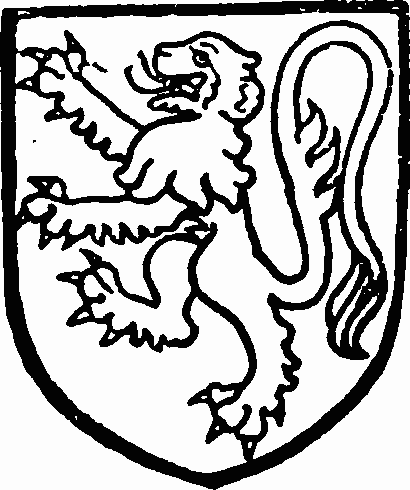
Bolebec. Vert a lion argent.
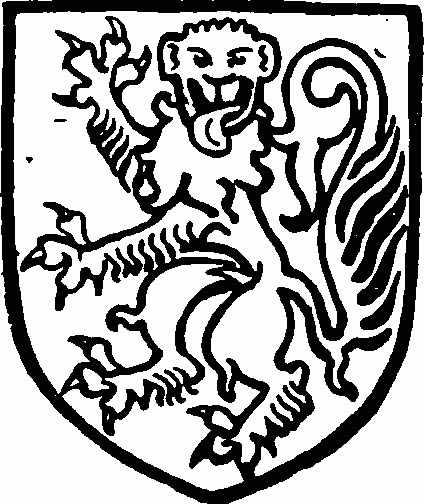
Marny. Gules a leopard rampant or.
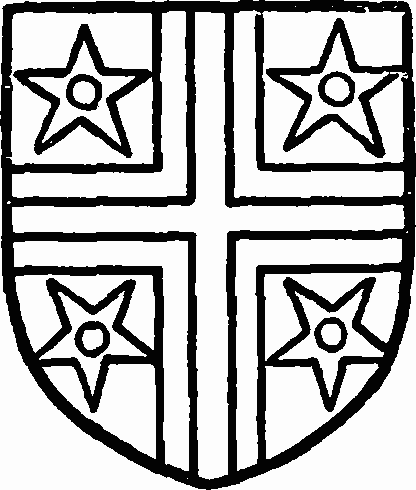
Spiller. Sable a cross voided between four pierced molets or.
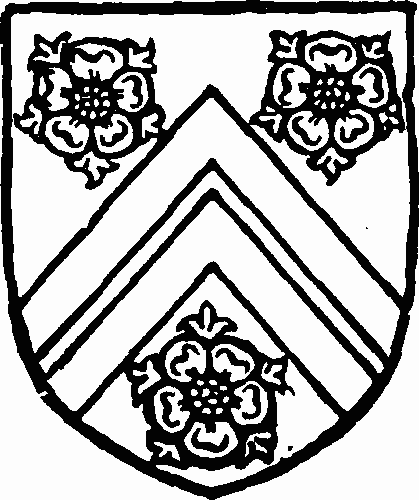
Wykeham. Argent two cheverons sable between three roses gules.
Gilbert de Bolebec claimed view of frankpledge in 1286, (fn. 90) and in the early 17th century this right is referred to as pertaining to the manor. (fn. 91)
Manorial Court Rolls are extant for the years 1318–24, (fn. 92) 1351–67, for 1414 and 1460, (fn. 93) also some Ministers' Accounts of the middle 14th (fn. 94) and 15th centuries. (fn. 95) A water-mill appertained to Kingsey Manor. (fn. 96)
An estate in Kingsey extending into Towersey was also called KINGSEY MANOR. Part of it appertained in the middle 14th century to Ewelme Manor, Oxfordshire, (fn. 97) and the whole was held in the early 15th century of the heirs of Sir John Neyrnut, (fn. 98) in 1473 of the king, (fn. 99) and in 1486 of Sir William Norris. (fn. 100)
Edmund Bacon held the land in Kingsey pertaining to Ewelme Manor at his death in 1336. (fn. 101) It had been settled in remainder on his heirs by his first wife Joan. (fn. 102) Their daughter Margaret had married William de Kerdeston, (fn. 103) and he was granted custody of these lands in 1337 during the minority of his daughter Maud (fn. 104) She afterwards married John Burghersh, who died in 1349, (fn. 105) and in 1362, on a final partition of Edmund Bacon's estates, Kingsey Manor was awarded to their son John Burghersh, then a minor. (fn. 106) He was granted seisin in 1366 (fn. 107) and died about 1392. (fn. 108) On the death of his widow Ismania in 1420 this manor passed by agreement with Thomas and Maud Chaucer in 1418 (fn. 109) to John and Margaret Arundell, Maud and Margaret being the daughters and co-heirs of John and Ismania Burghersh. (fn. 110) John Arundell died in 1423, (fn. 111) and in 1472 his son and heir Sir John Arundell conveyed the estate to John Henton and other feoffees (fn. 112) for the use of Geoffrey Dormer of Thame, an arrangement which was still holding later in the century. (fn. 113) In 1502 Geoffrey and Alice Dormer quitclaimed it for themselves and the heirs of Alice to their son Peter (fn. 114) and his wife Agnes. (fn. 115) This land does not reappear as a separate entity.
In 1086 Tythrop was assessed at 5 hides as part of the land of the Bishop of Bayeux. (fn. 116) Half this land, afterwards known as TYTHROP KINGSEY alias ROSE KINGSEY MANOR, had been subinfeudated by the bishop to Wadard. (fn. 117) It was afterwards attached to the barony of Arsic in Oxfordshire, (fn. 118) and paid 21s. 8d. yearly for the ward of Dover Castle. (fn. 119) The last reference to this overlordship occurs in 1602. (fn. 120)
In the middle of the 13th century Robert de la Rose held this half of Tythrop, (fn. 121) and he or another Robert de la Rose was holding it in 1261. (fn. 122) His daughter and heir married William Saunderton, (fn. 123) who was holding in 1279. (fn. 124) This land descended with Saunderton St. Mary to William Saunderton, (fn. 125) who in 1449 and 1450, with John and Alice Logge and others, conveyed Tythrop Manor to John Norris, (fn. 126) who made a settlement including it in 1462. (fn. 127) It does not appear, however, to have descended in his family. It is not included in the lands held by him at his death in 1467 (fn. 128) nor by his son William, who died about 1509, (fn. 129) although John, the latter's grandson and heir, (fn. 130) may be identical with the John Norris who, holding Tythrop Manor in right of his wife Elizabeth, quitclaimed it in 1523 to Sir Henry Marny. (fn. 131) From that time it descended with the principal manor of Kingsey (fn. 132) (q.v.) to Mr. Philip Digby Wykeham of Tythrop House, who is the present owner.
The other half of Tythrop, distinguished from Rose Kingsey in the early 17th century as WASECOURT alias BAYLIES HEYS MANOR, had been subinfeudated in 1086 by the Bishop of Bayeux to Ilbert Lacy, (fn. 133) and later appertained to the fee of Pontefract (fn. 134) and the earldom of Lincoln. (fn. 135) No reference to this overlordship has been found after the end of the 13th century. (fn. 136)
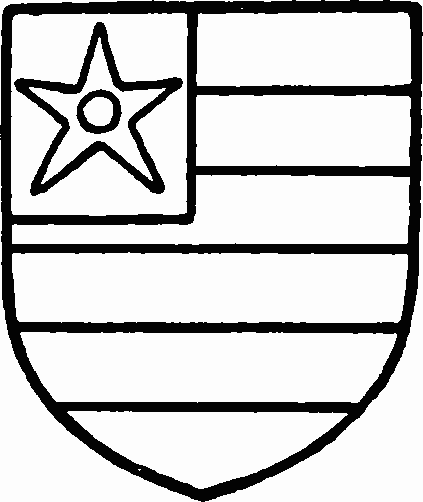
Wase. Barry argent and gales a quarter gules with a pierced molet argent therein.
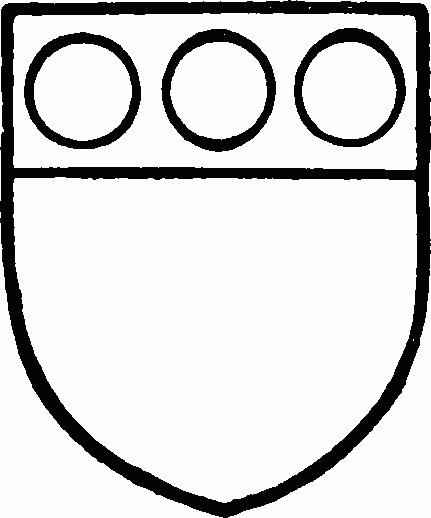
Camoys. Or a chif gules with three roundels argent therein.
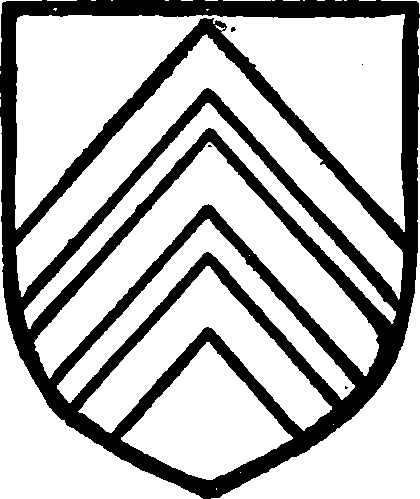
Lzwknor. Azure three cheverons or.
A mesne lordship in Tythrop was connected with Little Haseley, Oxfordshire. It was held by William de Brug and his wife Olive in her right in the early 13th century, (fn. 137) and apparently corresponds to that held later in the century by William de Stalebroc (fn. 138) and in 1279 by Robert son of Henry. (fn. 139) The Barantines or Barentynes held Little Haseley Manor for over two centuries, (fn. 140) and in 1478 Dru Barantine owned mesne lordship rights in Tythrop. (fn. 141)
Richard de Parco was tenant in Tythrop in the early 13th century, (fn. 142) Gilbert Wase (or Wace) later in the same century, (fn. 143) and William Wase in 1254. (fn. 144) He or another William Wase was holding this half of Tythrop in 1279 (fn. 145) and his son William (fn. 146) in 1346. (fn. 147) On the death of his son Sir Gilbert Wase in the early 15th century the Wase lands passed to a distant relative, Sir Richard Camoys. (fn. 148) His feoffees in 1416 granted TYTHROP MANOR to his widow Joan for life, with remainder successively in tail-male to his sons John, Ralph, and Hugh, and to his own right heirs. (fn. 149) On the death of Hugh second Lord Camoys, son of Sir Richard Camoys, in 1426, (fn. 150) his sisters and co-heirs were Margaret wife of Ralph Radmylde and Eleanor wife of Roger, afterwards Sir Roger Lewknor. (fn. 151) Ralph Radmylde died seised of half this manor in 1443, his wife having predeceased him. (fn. 152) Their son Robert, then a minor, (fn. 153) obtained a licence in 1448 to enter into his heritage without suing livery from the king. (fn. 154) It has not been found possible to trace the descent of this part of the original manor further.
On the death of Sir Roger Lewknor in 1478 the heritage of his wife Eleanor, including Tythrop Manor in Kingsey, passed to their son Thomas. (fn. 155) An Act of attainder and forfeiture against him was reversed in 1485. (fn. 156) His son Sir Roger Lewknor (fn. 157) after 1498 granted this property under the name of Kingsey Manor to Edmund Dudley for life. (fn. 158) Owing to his attainder it was taken into the king's hands in his lifetime. (fn. 159) In 1538 Sir Roger and Elizabeth Lewknor, with the concurrence apparently of their son-in-law William, afterwards Sir William Barantine, (fn. 160) conveyed this manor to Sir John Harecourt, (fn. 161) probably in trust, since Sir Roger Lewknor, in his will dated January 1542, left it 'as much as in me lyeth' to Roger Lewknor for life. (fn. 162) This property evidently passed later in the century into the same hands as Rose Kingsey (q.v.), and the farm of Wasecourt alias Baylies Heys about 1581 was leased by William Wright to his brother Edmund and transferred to the latter in 1591. (fn. 163) He settled it in 1594 in jointure on his second wife, Mary Norrington, who after his death in 1602 married James Fairborne and defended this property against her husband's son Edmund Wright. (fn. 164) In 1617 Mary Fairborne, then a widow, with Vincent Wright sold it to Sir Thomas Elliott and Edward Penn. (fn. 165) This property, as mentioned under Rose Kingsey (q.v.), had been previously granted by the Crown to Sir Henry Spiller, and is not afterwards distinguishable from the modern estate of Tythrop Manor.
At his death in 1349 Sir John Burghersh was tenant of part of the Wase lands in Tythrop, (fn. 166) corresponding apparently to the Tythrop Manor held by his son John's widow Ismania and their son-in-law Sir John Arundell in addition to the second manor in Kingsey (q.v.). Some property in Tythrop was included in the conveyance of that manor in 1502.
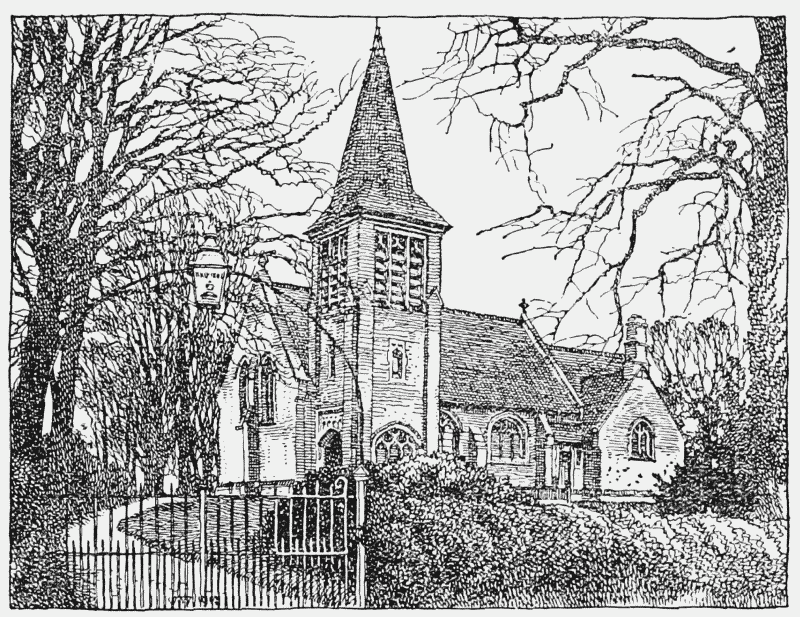
Kingsey Church from the South-west
A small property in Tythrop, called in the early 17th century ROLLES alias ROLVES, originally parcel of Kingsey Manor, was acquired in fee from Gilbert de Bolebec by Nicholas son of Adam de Risborough, and descended to his son Ralph and to Edmund son and heir of Ralph's son described as Gilbert Rolves. (fn. 167) Edmund Rolves and his wife Maud are referred to in 1353, (fn. 168) and the former died seised in 1361 and was succeeded by his son and heir John. (fn. 169) Rolves, then in the tenure of John Elmes or his assigns, was included in the grant to Sir Henry Spiller in 1610. (fn. 170)
Church
The church of ST. NICHOLAS, consisting of chancel, nave, organ chamber, vestry, and south-west tower with spire, is a modern building in the style of the 15th century, erected in 1892–3, to replace a late 18th-century church, much of the old material being re-used.
The tower contains a ring of three bells: the first, inscribed 'Feare God 1632,' is by Ellis Knight; the second, 1625, and the third, 1628, are both by James Keene; there is also a small bell undated.
The plate consists of a silver cup, two patens and a flagon, all given by James Herbert in 1710.
The registers begin in 1538.
Advowson
The advowson of Kingsey Church was alienated from the manor and given to Rochester Priory by Gilbert de Bolebec in the time of Henry III. (fn. 171) The church was then a chapel to Haddenham, (fn. 172) but in 1231 a vicar was instituted to it. (fn. 173) Kingsey Church was valued at £6 13s. 4d. yearly in 1291 (fn. 174) and at £8 13s. 4d. in 1535. (fn. 175) The advowson of the vicarage and also the rectory (leases excepted) have descended with that of Haddenham, (fn. 176) and belong to the Dean and Chapter of Rochester Cathedral.
Leases of the rectory were held by Thomas Boller in 1490 and 1517, (fn. 177) and by the Herberts of Kingsey and Tythrop (q.v.), who were also lessees of the advowson (fn. 178) in the 17th and 18th centuries. (fn. 179)
Lights in the church were maintained from lands called the Park and Foxhills. (fn. 180) Foxhill Close and the Lamplands were included in the grant of 1610 to Sir Henry Spiller. (fn. 181) Foxhills survives as the name of a farm.
Charities
Philip Herbert, by his will proved in the P.C.C. 14 July 1722, bequeathed £300 for the benefit of the poor; Ann Herbert, by her will proved in the P.C.C. 22 February 1810, bequeathed £100; and Philip Thomas Wykeham, by his will proved in the P.C.C. 29 October 1832, also bequeathed £100 for the poor. These legacies are now represented by £573 1s. 4d. consols.
Philip Thomas Herbert Wykeham, by his will proved at Oxford 12 July 1879, bequeathed £200 for the benefit of the poor, which was invested in £204 1s. 7d. consols. The sums of stock are held by the official trustees, the annual dividends of which, amounting together to £19 8s. 4d., are applied in the distribution of coal at Christmas among all the cottagers in the village, each receiving about 15 cwt.